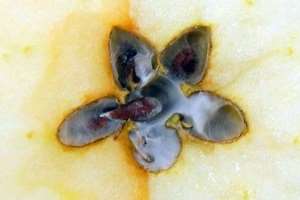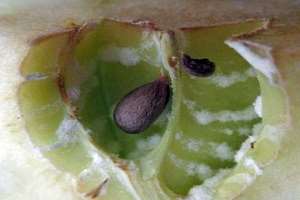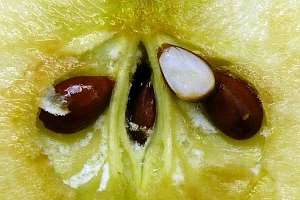Moldy core is characterized by the growth of fungus mycelium within the apple fruit seed cavity, without penetration into the flesh of the fruit.

The disease causes issue with cultivars that have an open sinus extending from the calyx into the core region. Management strategies haven’t been consistent; however, fungicides during bloom and cultural practices may help reduce infecting fungal populations.
Moldy core is one of those diseases that are not on folks’ radar until they cut open an apple. My email inbox is most filled with pictures of half-cut apples with questionable cores in late fall and during winter. Since the winter is a slow time for disease issues, I decided it was time to give moldy core the spotlight.
The moldy core fungi colonize the flower parts as soon as the blossoms open. The fungi then enter the developing fruit through an opening in the calyx. Moldy core is primarily a problem during years with light fruit set or when dry weather in early summer is followed by heavy rains in late summer. In addition, wet weather during bloom may cause conditions favorable for the fungi to produce spores. Mites have also been linked to carrying spores into the fruit via the calyx. Cultivars vary in their susceptibility to moldy core: those with an open sinus extending from the calyx into the core region are most prone (Red Delicious, Golden Delicious, Fuji). In contrast, Granny Smith and Braeburn apples are not as susceptible since they have small calyx openings.
There has been some confusion about moldy core symptoms. Moldy core is restricted to the core; it does not progress into the fruit flesh (see picture). When the fungi spread from the core into the flesh, causing the flesh to decay, it is called core rot. Moldy core and core rot are two different diseases. Fungi that are found in the core can be from several fungal species, such as Penicillium, Alternaria, and Botrytis. Depending on the infecting fungi, some moldy core can turn into core rot, but this does not happen all of the time. If you encounter an eating apple that has moldy core and not core rot, the flesh is still eatable should you choose to eat around the core.
I’ve received some pictures of apples where the core has white fuzzy tufts (see pictures below). We’ve determined in the lab these “white fuzzy tufts” in the core are not fungal, but part of the apple tissue. Consequently, these apples are perfectly fine and disease-free.


Management
There have been mixed results in fungicide trials to manage moldy core. Bloom is the time to manage for moldy core since the fungi grow from the flower parts into the open calyx tube and into the core region. The disease can be especially problematic when conditions are wet during bloom. Once the spores are inside the fruit, the disease cannot be controlled. The bloom period during the 2016 season was wet, which would have been ideal for moldy core. We did a cursory evaluation at the end of the season on a few Red Delicious fruit to see what fungicides we used during bloom and petal fall may help with moldy core management. This wasn’t an official evaluation; however, we did see fruit with less moldy core where an SDHI (FRAC group 7) and/or strobilurin (FRAC group 11) was used, as well as the tank mix of captan and mancozeb. For the 2017 season, we are going to pay close attention to determine if what we observed during 2016 is repeatable.
Nevertheless, growers should be mindful of what fungicides are being used during bloom on moldy core prone cultivars (Red Delicious, Golden Delicious, Fuji). A good miticide program should also be used since mites can be vectors for spores getting into the fruit. In addition, growers are encouraged to employ orchard practices that promote sanitation (debris removal below trees), fast drying conditions, good air movement and light penetration, which discourages spore development and germination.
Source: psu.edu